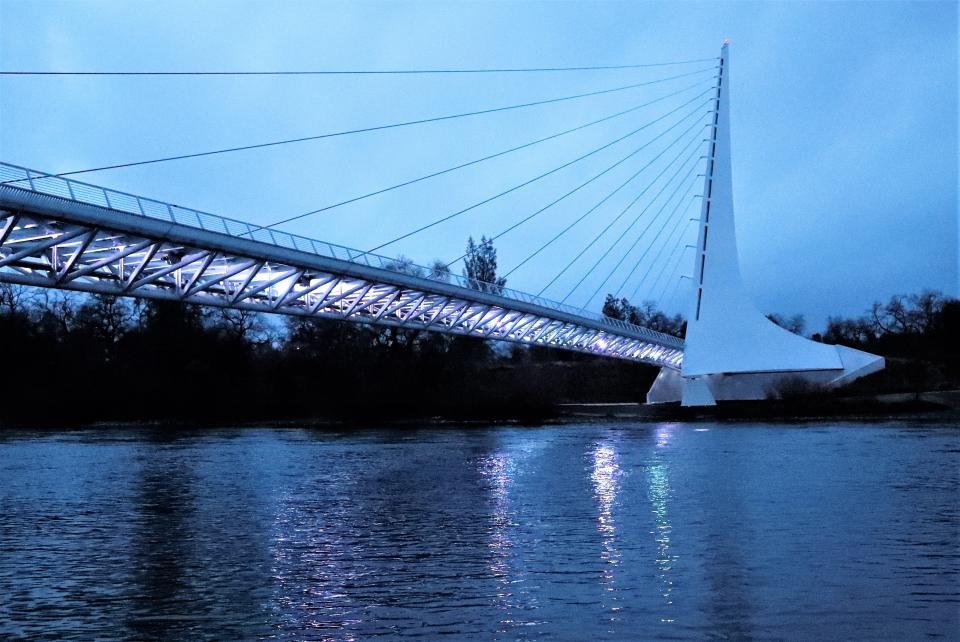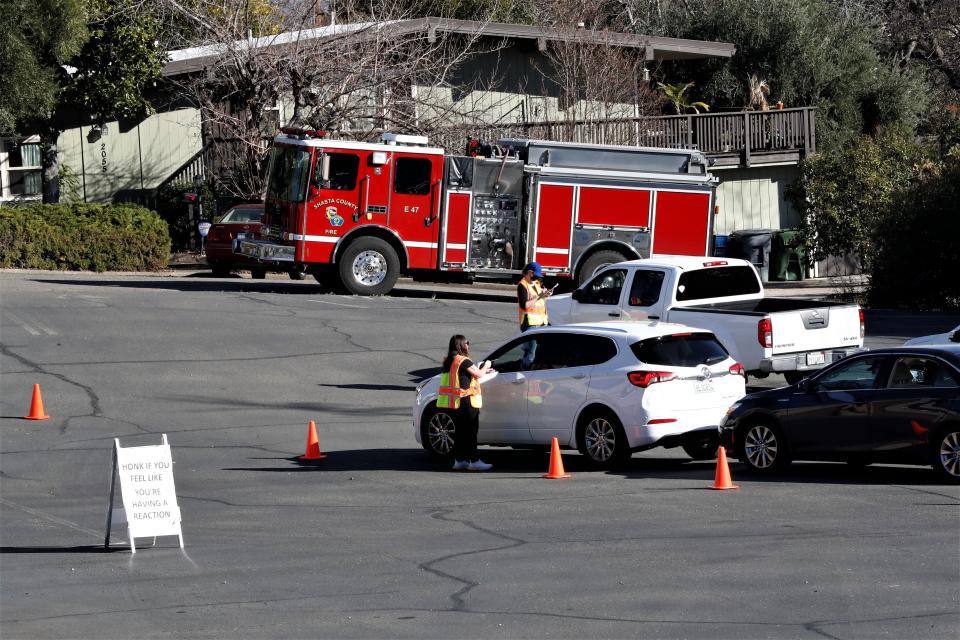Ask the R-S mailbag: How to virtually peek at the Sundial Bridge. Did nasal spray clobber COVID-19?
Ask the Record Searchlight is a newsroom-wide collaboration to connect with you, our readers. If you wondered about something happening in town or had questions on a North State issue, please email your questions to RRSEdit@redding.com. We'll do our best to answer in our live chat, our mailbag or in a story.
Our mailbag handles questions we were not able to answer in the Jan. 6 live chat held on Redding.com. The next live chat will happen on Jan. 20.
Questions have been edited for clarity, length and accuracy.
Scroll to the bottom of this story to find out how you can ask the Record Searchlight.
Sundial Bridge solves webcam woes?

Q: What has happened to the now-unavailable Sundial Bridge webcam?
A: Make that the formerly unavailable webcam on Redding's Sundial Bridge.
After being out of commission for weeks, the webcam trained on what has become the most iconic symbol in the city is up and running again.
"It’s back working on the new website!" wrote Redding Chamber of Commerce President and CEO Jake Mangas on Wednesday afternoon.
Latest help: Gov. Newsom vows to ramp up emergency relief amid California-wide coronavirus testing crunch
The webcam appears to be attached above a nearby gift shop run by the Turtle Bay Exploration Park and shows where people start their strolls across the bridge.
"We just launched a new website for Visit Redding and one of the things that is still being incorporated is the Sundial Bridge webcam," Mangas said last week, when the issue of the webcam on the fritz came up through a reader's Ask the Record Searchlight question.
The webcam's operations went on the blink after tourism efforts in the North State transitioned to the chamber last year. said Melissa Maney, guest services manager with Turtle Bay Exploration Park.
Weigh in: Open house to envision future of Redding’s South City Park happens Monday
Tourism promotions for the North State are now being handled by the chamber in conjunction with Development Counsellors International, a New York-based travel marketing company. The chamber hosts the webcam on the newly-revamped Visitredding.com website.
"We just launched a new website for Visit Redding and one of the things that is still being incorporated is the Sundial Bridge webcam," Mangas said.
Opened in 2004, the Sundial Bridge links the north and south campuses of Turtle Bay Exploration Park and has become a must-see spot for Redding visitors.
The webcam isn't the only camera keeping watch on the pedestrian bridge. There are security cameras in various other spots, Maney said.
Curious? The chamber's link to the Sundial Bridge webcam can be found here.
More: Ask the R-S mailbag: Sagging lines from utility poles an eyesore. Who's responsible?
— Michele Chandler

Nasal spray to crush COVID-19?
Q. My question is what has happened with the idea for an easy, commonly-made nasal spray to combat COVID-19? Was it found to be successful?
A. The idea was to create a simple-to-use method to ward off COVID-19.
The study was partially conducted in Redding in December 2020, before approved vaccines became widely available. The nasal spray study was part of a Stanford University-sponsored effort that came to Shasta Regional Medical Center to find study participants, in cooperation with Dr. George Domb, the Redding ear, nose and throat specialist who helped bring them to the medical facility.
Staff picks Ask the R-S all stars: Best of Ask the R-S mailbag 2021: Bethel grows. Gift card tips. County's 'secret' fund?
The local study was part of a larger effort investigating whether a nasal spray containing the common antiseptic Betadine was able to kill coronavirus inside the nose on contact.
Stanford wrapped up its study in early 2021.
Administering plain saline water was found to be about as effective as administering a Betadine-water solution in reducing the presence of the virus in the upper part of the throat that lies just behind the nose, Domb said during an interview in May. With either test treatment, the amount of virus able to be detected after three days was minimal, the university's study found, Domb said then.
Tell us more: How to submit letters, columns for Record Searchlight opinion section
"Both plain saline and Betadine in water killed the COVID-19 virus in the live human being," said Domb about the findings.
Back when the study took place, in December 2020, cases of COVID-19 were surging in Shasta County and across the country. Unlike now, there were no approved vaccines at that time.
With more than one vaccine widely available, Domb said last May, “The pressure for the Betadine to work is much less now.”
— Michele Chandler

Understanding high salmon death rates
Q. We are curious what caused the thiamine deficiency among female salmon in the winter run? Your article on Jan. 5 doesn't explain how the deficiency came about or how it is passed on to the offspring.
A. Winter-run chinook salmon are an endangered species that mainly spawn and hatch in the Sacramento River and tributaries in the Redding area. After they hatch the little fish swim out to the ocean, where they live until they are about 2 or 3 years old.
As adult salmon, they swim back to the rivers and streams where they were born. After spawning, the salmon die, completing their life cycle.
In 2021, only about 2.6% of the young winter-run salmon that hatched in the Redding area survived long enough to make it downstream as far as Red Bluff.
Ski restrictions: Mt. Shasta Ski Park limiting indoor activities due to omicron variant
Scientists point to two reasons for such a low survival rate.
One, warm water in the river killed the eggs and recent hatches, called fry. Two, the adults returning from the ocean had low levels of thiamine that they passed on to their young, according to a report from the National Marine Fisheries Service and Southwest Fisheries Science Center.
Scientists are still studying the role thiamine plays in fish survival. But they think the adult salmon “fed heavily on a narrow diet of northern anchovy concentrated off the Central California coast. Anchovies produce an enzyme called thiaminase that breaks down thiamine in salmon and is suspected of contributing to TDC (thiamine deficiency complex),” the report says.
At the Redding Civic: What's happening on Civic Auditorium's parking lot? More on the Hilltop senior center.
So why were salmon eating so many anchovies? The report says other salmon prey, such as krill — a small, shrimp-like species that is vital to the sea creature food chain — fell to unusually low levels in 2019. Warming seas and over-harvesting of krill are likely to blame, according to science journal PLOS.
The thiamine deficiency is not unique to the Pacific Ocean off the California coast. It also has been seen in salmon in other parts of the world.
— Damon Arthur
How Ask the Record Searchlight works
Participate by sending your questions. Post them in the comments section of this story or:
Email RRSEdit@redding.com using Ask the Record Searchlight in the subject line.
On Twitter, use the hashtag #AsktheRecordSearchlight or tag the newspaper at @BreakingNews_RS.
Post a message on the Record Searchlight Facebook page.
Contact one of the journalists directly by visiting the staff directory.

Michele Chandler covers city government and housing issues for the Redding Record Searchlight/USA Today Network. Follow her on Twitter at @MChandler_RS, call her at 530-225-8344 or email her at michele.chandler@redding.com. Please support our entire newsroom's commitment to public service journalism by subscribing today.
This article originally appeared on Redding Record Searchlight: Redding's Sundial Bridge webcam restored. Here's what you can see.

